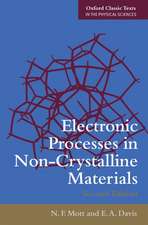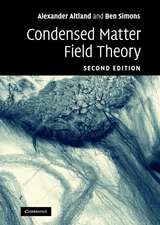Chemistry and Physics of Solid Surfaces VI: Springer Series in Surface Sciences, cartea 5
Editat de Ralf Vanselow, Russell Hoween Limba Engleză Paperback – 22 dec 2011
Din seria Springer Series in Surface Sciences
- 18%
 Preț: 1131.25 lei
Preț: 1131.25 lei - 15%
 Preț: 654.77 lei
Preț: 654.77 lei - 18%
 Preț: 1113.09 lei
Preț: 1113.09 lei -
 Preț: 390.63 lei
Preț: 390.63 lei -
 Preț: 407.98 lei
Preț: 407.98 lei - 15%
 Preț: 657.57 lei
Preț: 657.57 lei - 15%
 Preț: 636.63 lei
Preț: 636.63 lei - 15%
 Preț: 641.20 lei
Preț: 641.20 lei - 15%
 Preț: 651.19 lei
Preț: 651.19 lei - 15%
 Preț: 645.60 lei
Preț: 645.60 lei - 15%
 Preț: 632.70 lei
Preț: 632.70 lei - 15%
 Preț: 640.24 lei
Preț: 640.24 lei - 15%
 Preț: 646.11 lei
Preț: 646.11 lei -
 Preț: 397.38 lei
Preț: 397.38 lei -
 Preț: 386.22 lei
Preț: 386.22 lei -
 Preț: 387.75 lei
Preț: 387.75 lei -
 Preț: 389.31 lei
Preț: 389.31 lei -
 Preț: 399.12 lei
Preț: 399.12 lei -
 Preț: 406.42 lei
Preț: 406.42 lei - 18%
 Preț: 1011.14 lei
Preț: 1011.14 lei - 18%
 Preț: 2100.88 lei
Preț: 2100.88 lei -
 Preț: 398.35 lei
Preț: 398.35 lei -
 Preț: 392.21 lei
Preț: 392.21 lei -
 Preț: 389.88 lei
Preț: 389.88 lei - 15%
 Preț: 646.43 lei
Preț: 646.43 lei - 15%
 Preț: 643.16 lei
Preț: 643.16 lei - 15%
 Preț: 643.65 lei
Preț: 643.65 lei - 18%
 Preț: 948.79 lei
Preț: 948.79 lei - 15%
 Preț: 641.03 lei
Preț: 641.03 lei - 15%
 Preț: 640.55 lei
Preț: 640.55 lei - 15%
 Preț: 640.71 lei
Preț: 640.71 lei - 18%
 Preț: 952.72 lei
Preț: 952.72 lei - 18%
 Preț: 955.08 lei
Preț: 955.08 lei - 15%
 Preț: 648.42 lei
Preț: 648.42 lei - 15%
 Preț: 641.03 lei
Preț: 641.03 lei - 18%
 Preț: 1000.42 lei
Preț: 1000.42 lei - 18%
 Preț: 952.57 lei
Preț: 952.57 lei - 18%
 Preț: 1001.02 lei
Preț: 1001.02 lei
Preț: 409.13 lei
Nou
Puncte Express: 614
Preț estimativ în valută:
78.32€ • 80.59$ • 66.02£
78.32€ • 80.59$ • 66.02£
Carte tipărită la comandă
Livrare economică 01-15 martie
Preluare comenzi: 021 569.72.76
Specificații
ISBN-13: 9783642827297
ISBN-10: 3642827292
Pagini: 692
Ilustrații: XVII, 667 p.
Dimensiuni: 152 x 229 x 36 mm
Greutate: 0.91 kg
Ediția:Softcover reprint of the original 1st ed. 1986
Editura: Springer Berlin, Heidelberg
Colecția Springer
Seria Springer Series in Surface Sciences
Locul publicării:Berlin, Heidelberg, Germany
ISBN-10: 3642827292
Pagini: 692
Ilustrații: XVII, 667 p.
Dimensiuni: 152 x 229 x 36 mm
Greutate: 0.91 kg
Ediția:Softcover reprint of the original 1st ed. 1986
Editura: Springer Berlin, Heidelberg
Colecția Springer
Seria Springer Series in Surface Sciences
Locul publicării:Berlin, Heidelberg, Germany
Public țintă
ResearchCuprins
1. Georg-Maria Schwab: Early Endeavours in the Science of Catalysis.- References.- 2. The Life and Times of Paul H. Emmett.- 3. Three Decades of Catalysis by Metals.- 3.1 Bifunctional Catalysis.- 3.2 Characterization of Dispersed Metals.- 3.2.1 Chemisorption Isotherms.- 3.2.2 Application of Extended X-Ray Absorption Fine Structure.- 3.2.3 Application of Nuclear Magnetic Resonance.- 3.3 Hydrocarbon Reactions on Metals.- 3.3.1 Hydrogenolysis.- 3.3.2 Hydrogenation and Dehydrogenation.- 3.3.3 Isomerization.- 3.4 Bimetallic Catalysts.- 3.4.1 Metal Alloys as Catalysts.- 3.4.2 Bimetallic Aggregates of Immiscible Components.- 3.4.3 Bimetallic Clusters.- 3.5 Summary.- References.- 4. Molecular Organometallic Chemistry and Catalysis on Metal-Oxide Surfaces.- 4.1 Synthesis.- 4.2 Structure Determination by Physical Methods.- 4.2.1 Infrared Spectroscopy.- 4.2.2 Laser Raman Spectroscopy.- 4.2.3 Inelastic Electron Tunneling Spectroscopy.- 4.2.4 Extended X-Ray Absorption Fine Structure Spectroscopy.- 4.2.5 Ultraviolet-Visible Reflectance Spectroscopy.- 4.2.6 Nuclear Magnetic Resonance (NMR).- 4.2.7 Temperature-Programmed Decomposition.- 4.2.8 High-Resolution Transmission Electron Microscopy.- 4.2.9 Other Methods and General Points.- 4.3 Reactivity.- 4.4 Catalytic Activity.- 4.5 Supported Metals with Simple Structures Derived from Supported Organometallics.- 4.6 Summary.- References.- 5. Catalysis by Molybdena-Alumina and Related Oxide Systems.- 5.1 Nature of the Catalyst.- 5.2 Nature of the Catalytic Centers.- 5.3 The Chemisorption of Hydrogen on the Catalytic Centers.- 5.4 Relationships with Catalysis.- References.- 6. Structure and Catalytic Performance of Zeolites.- 6.1 Introduction to Zeolites.- 6.2 Some Structural Considerations.- 6.3 Fundamentals of Catalysis by Zeolites: A Resumè.- 6.4 Converting a Zeolite to Its Catalytically Active Form.- 6.5 Influence of Intergrowths on Catalytic Performance.- 6.6 Siting and Energetics of Guest Species Inside Zeolite Catalysts.- 6.7 Evaluating Currently Unsolved Zeolitic Structures.- 6.8 Analogy Between Zeolitic and Selective Oxidation Catalysts.- References.- 7. Structural Characterization of Molecules and Reaction Intermediates on Surfaces Using Synchrotron Radiation.- 7.1 Principles of X-Ray Absorption.- 7.1.1 General Features.- 7.1.2 Surface Extended X-Ray Absorption Fine Structure.- 7.1.3 Near Edge X-Ray Absorption Fine Structure.- 7.1.4 Apparatus.- 7.2 SEXAFS Studies of Polyatomic Adsorbates.- 7.2.1 Structure of Formate on the Cu{100} Surface.- 7.2.2 Structure of Formate on the Cu{110} Surface.- 7.2.3 Structure of Methoxy on the Cu{100} Surface.- 7.3 NEXAFS Studies of Polyatomic Adsorbates.- 7.3.1 Oxidation Intermediates on Cu{100} and Cu{110}.- 7.3.2 Hydrocarbons on Pt{111}.- 7.3.3 Sulfur-Containing Hydrocarbons on Pt{111}.- 7.4 Conclusions and Outlook.- References.- 8. Effects of Surface Impurities in Chemisorption and Catalysis.- 8.1 Experimental Details.- 8.2 Discussion.- 8.2.1 Electronegative Impurities.- a) Chemisorption.- b) Catalytic Activity.- c) Catalytic Selectivity.- 8.2.2 Electroneutral Impurities.- a) Copper Overlayer Structure.- b) Chemisorption.- c) Catalytic Activity.- 8.2.3 Electropositive Impurities.- a) Chemisorption.- b) Carbon Monoxide Dissociation Kinetics.- c) Methanation Kinetics.- d) Promotion of Higher Hydrocarbon Formation.- e) Electronic Compensation Effects.- 8.2.4 Related Theory.- 8.3 Conclusions.- References.- 9. Thermodynamics and Kinetics in Weakly Chemisorbed Phases.- 9.1 Evaluation of the Isosteric Heat and Entropy of Adsorption.- 9.2 Correlation BetweenThermodynamic and Kinetic Experiments.- 9.3 Structural and Thermodynamic Data on Weakly Chemisorbed Phases.- 9.3.1 Phase Diagram for N2 Adsorbed on Ni{110} and Data for N2 on Ni {100}.- 9.3.2 The Isosteric Heat of Adsorption and the Entropy in the Adsorbed Phase for N2/Ni{110} and N2/NHIOO}.- 9.3.3 Carbon Monoxide on Low-Index Copper Single Surfaces.- 9.3.4 Thermodynamic Measurements at Very Small Coverages.- 9.4 Kinetics in Weakly Adsorbed Phases.- 9.4.1 Adsorption and Desorption Kinetics.- 9.4.2 Chemical Reactions in Weakly Chemisorbed Phases.- 9.5 Summary.- References.- 10. Kinetic and Spectroscopic Investigations of Surface Chemical Processes.- 10.1 Experimental Methods.- 10.2 Kinetic Studies of Methanol Decomposition on Ni{111}.- 10.2.1 Isothermal Decomposition of Methanol on Clean Ni{111}.- 10.2.2 Steady-State Kinetics of Methanol Decomposition on Ni {111}.- 10.3 Scanning Kinetic Spectroscopy (SKS) Methods for the Study of the Decomposition of Alcohols on Ni{111}.- 10.3.1 Rationale for the SKS Method.- 10.3.2 Methanol Decomposition on Ni{111} —SKS Measurements.- 10.3.3 Ethanol Decomposition on Ni{111} Using SKS.- 10.4 Summary of Results.- References.- 11. Raman Spectroscopy of Adsorbed Molecules.- 11.1 Unenhanced Raman Spectroscopy of Adsorbed Molecules.- 11.1.1 Surface Electromagnetic Fields.- 11.1.2 Angle-Resolved Surface Raman Scattering.- 11.1.3 Selection Rules.- 11.1.4 Examples.- 11.2 Surface-Enhanced Raman Spectroscopy.- 11.2.1 Electromagnetic Enhancement.- 11.2.2 Chemical Enhancement.- 11.3 Future Work.- References.- 12. The Time-of-Flight Atom-Probe and Its Application to Surface Analysis and Gas-Surface Interactions.- 12.1 The Time-of-Flight Atom-Probe.- 12.1.1 Basic Principles.- 12.1.2 Mass Resolution.- 12.1.3 Pulsed High-Voltage Atom-Probes.- 12.1.4The Pulsed-Laser Time-of-Flight Atom-Probe.- 12.1.5 A Statistical Method of Counting Single Ions.- 12.1.6 Imaging Atom-Probes.- 12.1.7 A Method for Ion-Reaction-Time Amplification.- 12.2 Structural and Compositional Analysis of Solid Surfaces.- 12.2.1 Atomic Structures of Emitter Surfaces.- 12.2.2 Compositional Analysis of Surface Atomic Layers: Alloy Segregations and Impurity Segregation.- 12.3 Gas-Surface Interactions.- 12.3.1 Field Adsorption.- 12.3.2 Surface Reactivity in the Formation of H3.- 12.3.3 Atomic Steps and Reaction Intermediates in Ammonia Synthesis.- 12.4 Ion-Reaction-Time Measurement — Field Dissociation by Atomic Tunneling.- 12.5 Summary.- References.- 13. Field Emission Microscopy—Trends and Perspectives.- 13.1 Historical Background.- 13.2 Some Comments Related to Curved and Planar Surfaces.- 13.3 Field-Electron Emission Microscopy.- 13.3.1 Conceptual.- 13.3.2 The Microscopy.- a) The Microscope.- b) Magnification.- c) Contrast.- d) Resolution.- e) The Specimen.- f) Criteria for a Clean Surface.- g) Specimen Materials.- 13.3.3 Selected Field-Electron Emission Microscopy Research.- a) Visibility of Atomic and Molecular Objects.- b) Surface Diffusion.- c) Nucleation and Crystal Growth.- d) Cleaning Platinum Field Emitters.- e) Electron Energy Distributions.- 13.4 Field-Ion Microscopy.- 13.4.1 The Microscopy.- a) The Microscope.- b) The Image.- c) More About Field Evaporation.- d) The Specimen.- 13.4.2 Selected Field-Ion Microscopy Research.- a) Surface Diffusion.- b) Clean-Surface bcc{001} Atomic Structure.- 13.5 Summary and Future Outlook.- References.- 14. Scanning Tunneling Microscopy.- 14.1 Introduction.- 14.2 Experimental Considerations.- 14.3 Tunnel Current and Tunnel Barrier.- 14.3.1 Basic Model Calculations and Approximations.- 14.3.2Calculations for Nonplanar Tip-Surface Geometries.- 14.3.3 The Effect of the Image Potential.- 14.3.4 Resolution of the STM.- 14.3.5 Sample Conductivity.- 14.3.6 Effect of Adsorbates.- 14.4 Surface Microscopy.- 14.4.1 Topography of Flat Surfaces.- 14.4.2 Periodic Structures of Single-Crystalline Surfaces.- 14.4.3 Surface Defects.- 14.4.4 Reactivity and Stability of Surfaces.- 14.4.5 Non-Surface-Science Applications of the STM.- 14.4.6 Surface Diffusion and Surface Mobility.- 14.5 Tunneling Spectroscopy.- 14.5.1 Valence Band Spectroscopy.- 14.5.2 Resonant Tunneling.- 14.5.3 Scanning Tunneling Spectroscopy.- 14.5.4 The Work Function and Work Function Images.- 14.6 Conclusions.- References.- 15. High-Resolution Electron Microscopy in Surface Science.- 15.1 Imaging Methods.- 15.1.1 Transmission Electron Microscopy.- 15.1.2 Reflection Electron Microscopy.- 15.2 Instrumentation and Accessories.- 15.3 Survey of Results.- 15.3.1 Bright-Field Transmission Electron Microscopy.- 15.3.2 Dark-Field Transmission Electron Microscopy.- 15.3.3 Reflection Electron Microscopy.- 15.3.4 Profile Imaging.- 15.3.5 Dynamic Processes.- 15.3.6 Image Contrast Calculations.- 15.4 Perspective and Outlook.- 15.5 Further Reading.- References.- 16. Surface Electronic States.- 16.1 Experimental Techniques.- 16.2 Valence Electronic States: Ideal Surfaces.- 16.3 Valence States: New Developments.- 16.4 Core Levels: Surfaces and Interfaces in Technology.- References.- 17. The Use of Spin-Polarized Electrons in Surface Analysis.- 17.1 Introduction to Spin-Polarized Electrons.- 17.2 Nonmagnetic Materials.- 17.2.1 Electron Diffraction.- 17.2.2 Application of Spin-Polarized LEED: Spin-Polarization Detectors.- 17.2.3 Photoemission.- 17.2.4 Application of Spin-Polarized Photoemission: Polarized Electron Sources.- 17.3 Magnetic Materials.- 17.3.1 Elastic Electron Scattering.- 17.3.2 Secondary Electron Emission and Magnetic Structure Analysis.- 17.3.3 Electronic Structure and Stoner Excitations.- 17.4 Conclusion.- References.- 18. Inverse Photoemission Spectroscopy.- 18.1 Historical Overview.- 18.2 Instrumentation.- 18.3 Density of States.- 18.4 Band Structures and Surface States.- 18.5 Adsorbate States.- 18.6 Summary and Outlook.- References.- 19. The Structure of Surfaces.- 19.1 Structure of the GaAs{lll}-(2 x2) Surface.- 19.1.1 Reconstruction Mechanisms on the GaAsdll} Surface.- 19.1.2 Vacancy-Buckling Model of GaAs{lll}-(2×2).- 19.2 Structure of the GaAs{110}-(l ×1) Surface.- 19.2.1 Surface Relaxation on the {110} Surface.- 19.2.2 Value of the ? Tilt Angle on the {110} Surface.- 19.3 Structure of the GaP{lll}-(2 x2) Surface.- 19.4 General Trend on Reconstructed {110} and {111} Faces of 111-V Compounds.- 19.5 Forward-Focusing Effects in X-Ray Photoemission Spectroscopy.- 19.5.1 Physical Origin of Peaks in Egelhoff’s- Experiment.- 19.5.2 The Small-Atom (Plane-wave) Approximation.- 19.5.3 Temperature Effect.- 19.5.4 Effect of Multiple Scattering.- 19.6 Structure Analysis by High-Resolution Electron Energy-Loss Spectroscopy.- 19.7 Conclusion.- References.- 20. Surface Structure Analysis by Low-Energy Alkali Ion Scattering.- 20.1 Theoretical Background.- 20.1.1 Single Scattering and Differential Scattering Cross Section.- 20.1.2 Double Scattering.- 20.1.3 Shadowing, Blocking, and Focusing; Thermal Vibrations; Inelastic Scattering.- 20.1.4 Neutralization.- 20.2 Experimental Techniques.- 20.3 Basic Studies of the Scattering Mechanisms.- 20.4 Structure Analysis.- 20.5 Conclusions and Summary.- References.- 21. Multilayer Adsorption and Wetting Phenomena.- 21.1 Introduction toWetting and Layering Behaviors.- 21.2 Theoretical Approaches.- 21.3 Applications.- 21.3.1 Importance of Relative Potential Strengths and Ranges.- 21.3.2 Solid Films: Wetting and Melting.- 21.3.3 Triple-Point Wetting.- 21.3.4 Epitaxy.- 21.4 Summary and Future Directions.- References.- 22. Diffraction Studies of Layering and Wetting Transitions.- 22.1 Introduction.- 22.2 Electron Diffraction Studies of Wetting Behavior.- 22.2.1 Experimental Methods.- 22.2.2 RHEED Studies of Wetting.- a) Two- and Three-Dimensional Diffraction Patterns — Streaks vs. Spots.- b) Experimental Results.- 22.2.3 Combined RHEED and LEED Studies of the CF4-on- Graphite Wetting Transition.- a) RHEED Measurements.- b) LEED Measurements.- 22.2.4 Summary of RHEED and LEED Investigations.- 22.3 X-Ray and Neutron Studies of Layering Transitions.- 22.3.1 Experimental Methods.- a) X-Ray Spectrometers.- b) Neutron Spectrometers.- c) Samples.- d) Diffraction from 2D Powders.- e) Samples and Thermometry.- 22.3.2 X-Ray and Neutron Studies of Layering Transitions in Ethylene Adsorbed on Graphite Basal Plane Surfaces.- 22.3.3 X-Ray and Neutron Studies of Layering Transitions in Co-Adsorbed Xenon and Ethylene Films on Graphite.- 22.3.4 Summary of X-Ray and Neutron Investigations.- References.

















